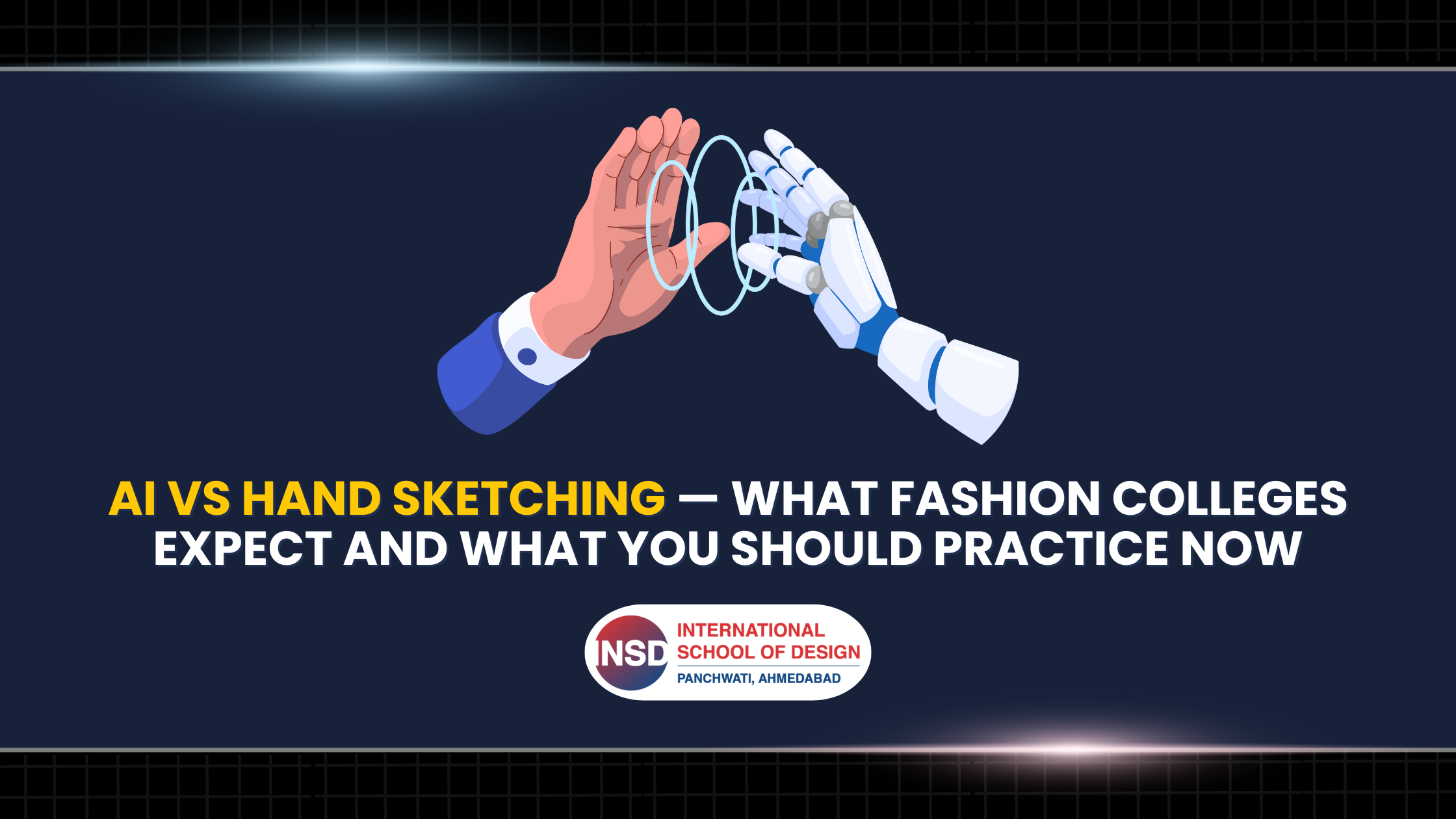If you’re a Class 12 student dreaming of a career in fashion design, you’ve probably asked yourself: “Should I focus on traditional sketching, or start using AI tools now?” This is a question many aspiring designers face today. Fashion colleges increasingly value students who can combine traditional creativity with digital proficiency, and starting early gives you a significant advantage.
In this guide, we’ll explore why both hand sketching and AI tools matter, what colleges expect from applicants, and practical exercises you can start doing in Class 12 to build the right skills.
Why Fashion Colleges Value Both Hand Sketching and AI Skills
Fashion design is a blend of art, technology, and problem-solving. Admissions committees look for students who demonstrate:
- Creativity and originality (hand sketches show your personal design style)
- Technical ability (precision, proportion, and construction understanding)
- Digital literacy (AI and design software proficiency)
Hand sketches reflect your observational skills, thought process, and artistic sensibility, while AI tools demonstrate your ability to adapt to industry trends, speed up workflows, and generate ideas digitally. Students who master both are more likely to succeed in bachelor’s or diploma programs and eventually in professional design careers.
Hand Sketching: Why It’s Still Essential
Even in the age of AI, hand sketching remains the backbone of fashion design education. Here’s why:
- Creative Intuition
Sketching by hand develops your ability to translate concepts into visual forms without relying on pre-existing templates or AI prompts. - Observation and Detailing
Drawing outfits, textures, and accessories sharpens your eye for detail, which is critical for fabric patterns, stitching techniques, and garment construction. - Personal Style Development
Your sketches showcase your unique voice as a designer, which AI-generated images can’t replicate. Colleges often evaluate how distinct your hand sketches are when reviewing portfolios.
Class 12 Exercise: Dedicate 20–30 minutes daily to sketching outfits, experimenting with silhouettes, fabrics, and accessories. Even simple pencil sketches demonstrate your commitment and skill growth over time.
AI Tools in Fashion Design: How They Are Used Today
AI is transforming fashion design, not replacing creativity. Modern designers use AI for:
- Trend Analysis: Platforms like Fashwell and CALA predict color, fabric, and style trends.
- Rapid Visualization: AI tools like Adobe Firefly and Midjourney generate multiple design concepts from a single prompt.
- Digital Mood Boards & Collections: Tools like Canva or Figma help students present ideas professionally.
Starting early with AI allows Class 12 students to experiment with design variations quickly, explore sustainable fabrics digitally, and translate inspiration into visual concepts for their portfolios.
Balancing Both Skills Before College
Fashion colleges expect students to have foundational hand sketching skills AND a comfort level with digital design tools. Here’s how you can balance both in Class 12:
- Daily Sketching (20–30 Minutes)
Focus on human figures, silhouettes, accessories, and garment details. Use pencil or pen and try to create different variations of a single design concept. - AI Exploration (15–20 Minutes)
Experiment with AI-powered tools to generate fashion concepts, color palettes, or patterns. Analyze how AI interprets your ideas and translate the results back into hand sketches for refinement. - Portfolio Integration
Combine hand sketches with AI-assisted visuals to demonstrate versatility and adaptability. Admissions officers often value portfolios that blend creativity and technology.
Sample Exercises for Class 12 Students
Here are some practical exercises to start now:
- Silhouette Challenge: Draw 5–10 different outfit silhouettes in 15 minutes. Focus on proportions and style.
- Fabric & Texture Study: Sketch fabric folds, pleats, or drape effects by observing real clothes.
- AI-Assisted Mood Board: Use Canva or Midjourney to create a digital board, then reinterpret one concept by hand.
- Accessory Focus: Draw jewelry, belts, or shoe designs to add detail and polish to your sketches.
- Trend Recreation: Pick a fashion trend from social media or runway, sketch it by hand, then compare with AI-generated variations.
By rotating these exercises daily, you’ll develop a well-rounded skill set that impresses fashion colleges.
Portfolio Development: What Colleges Look For
A strong portfolio shows more than talent—it shows discipline, creativity, and adaptability. When preparing for admissions:
- Include hand sketches, even rough ones; they reflect your thought process.
- Add AI-generated visual explorations to demonstrate digital proficiency.
- Show variations and iterations; colleges want to see how you explore and refine ideas.
- Keep a consistent theme or style to highlight your design sensibility.
Class 12 students who start practicing now will enter fashion college with a mature, polished portfolio, giving them a significant advantage over peers who wait until the first semester.
Why INSD Ahmedabad Prepares You for Both Worlds
If you want to master both hand sketching and AI tools for a career in fashion design, INSD Ahmedabad offers the perfect platform.
Students at INSD Ahmedabad:
- Learn from industry-experienced mentors who balance traditional techniques with modern digital tools
- Practice AI-integrated design workflows, CAD, and digital fashion software alongside hand sketching
- Build a portfolio showcasing creativity, technical skills, and adaptability
- Choose between online and offline programs, including bachelor’s, diploma, and certificate courses in fashion design, textile design, and styling
By combining your daily practice at home with structured guidance at INSD Ahmedabad, you’ll enter college confident, skilled, and portfolio-ready, with the ability to navigate both traditional and AI-driven design workflows.
Takeaway: Fashion design students in Class 12 should practice hand sketching daily while experimenting with AI tools. Balancing both strengthens observation, creativity, and digital literacy—qualities fashion colleges now expect. Start small, stay consistent, and gradually build a portfolio that demonstrates your versatility and readiness for a professional design career. INSD Ahmedabad provides the mentorship, tools, and guidance to turn early practice into a successful fashion design journey.


